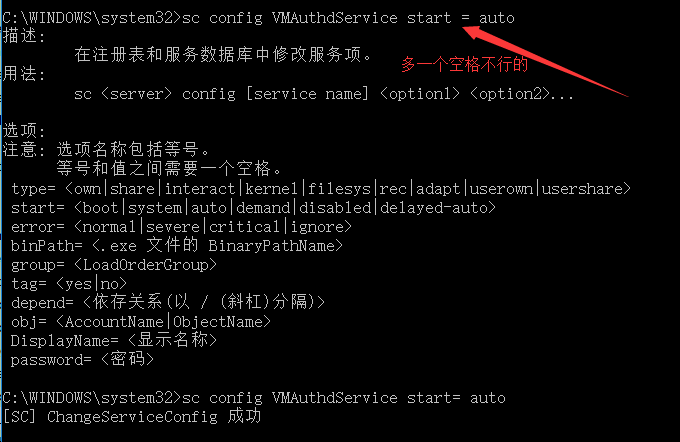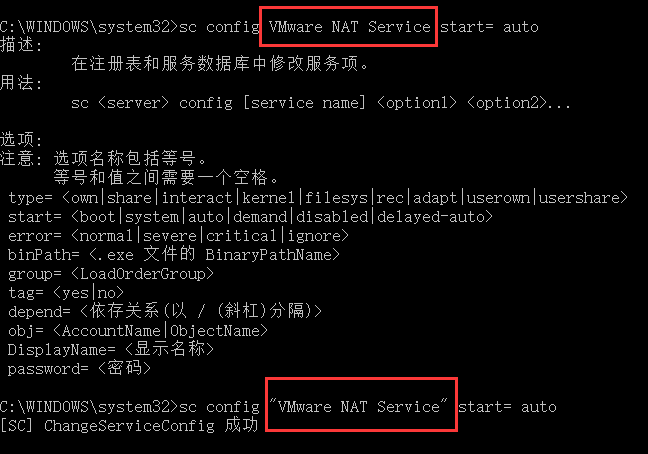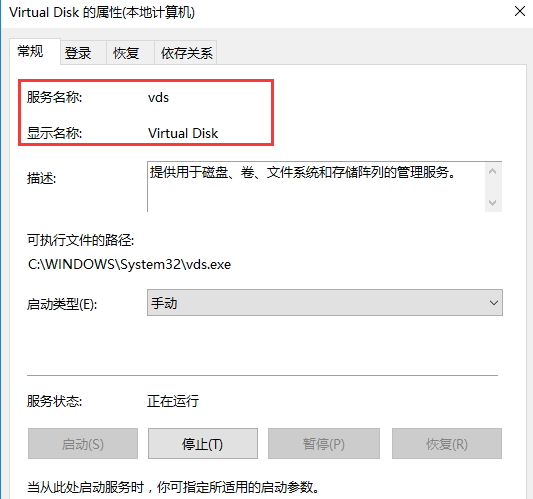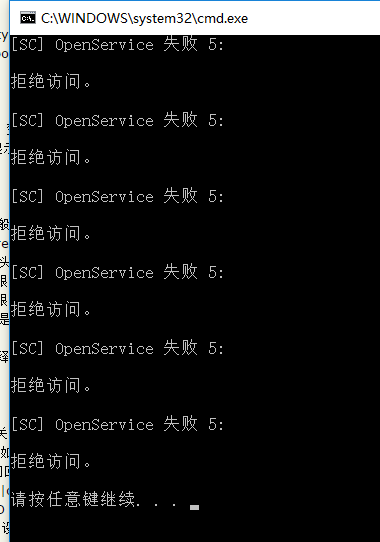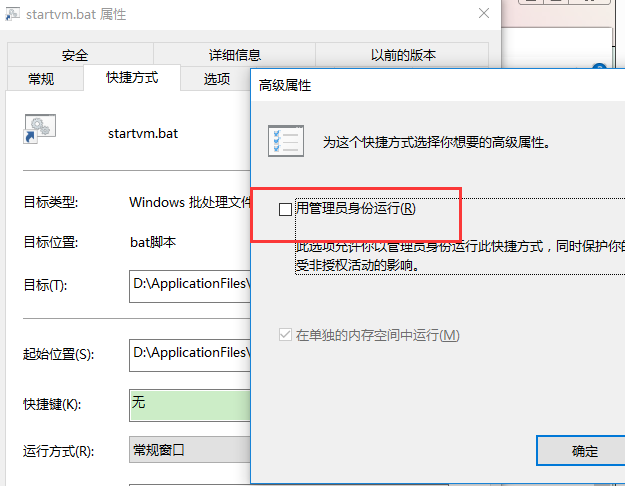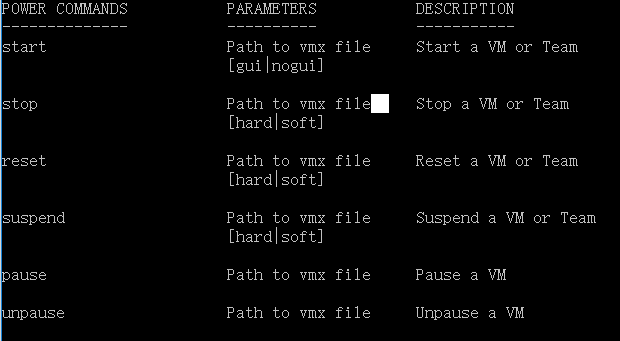批處理啟動vm虛擬機器服務 vm12啟動無介面啟動vm虛擬機器系統 windows上如何操作服務 sc net啟動關閉服務
windows(win10)批處理指令碼
開啟vm虛擬機器的服務,並且開啟無介面虛擬機器
@echo off
net start "vds"
net start "VMAuthdService"
net start "VMnetDHCP"
net start "VMware NAT Service"
net start "VMUSBArbService"
net start "VMwareHostd"
"D:\ApplicationFiles\System\VMware Workstation\vmrun.exe" start "F:\virtualMachine\ubuntu15.1X64\ubuntu15.1X64.vmx" nogui
儲存為startvm.bat
@echo off
"D:\ApplicationFiles\System\VMware Workstation\vmrun.exe" stop "F:\virtualMachine\ubuntu15.1X64\ubuntu15.1X64.vmx" nogui
net stop "vds"
net stop "VMnetDHCP"
net stop "VMware NAT Service"
net stop "VMwareHostd"
net stop "VMUSBArbService"
net stop "VMAuthdService"
儲存為shutdownvm.bat
說明:
D:\ApplicationFiles\System\VMware Workstation\vmrun.exe 為虛擬機器安裝目錄/ps:如果你把vmrun路徑加入了環境變數path後,可以直接使用命令vmrun
F:\virtualMachine\ubuntu15.1X64\ubuntu15.1X64.vmx 為虛擬機器檔案位置
生成的檔案建立快捷方式,右鍵-屬性-高階,設定下管理員許可權執行,以後雙擊即可執行
開啟還要等個一分鐘左右啟動好,具體看你的系統性能
接下來就可以正常ssh連線了
-------------------------------------------
下面重點說一下用到的知識點原理
一,首先說一下,window上面如何操作服務(win10 x64)
windows上使用sc命令net命令設定操作服務,批處理關閉服務命令 開啟服務命令
使用sc命令:
1 修改服務啟動型別
sc config 服務名 start= demand (設定服務為手動啟動)
start= auto (設定服務為自動啟動)
start= disabled (設定服務為禁用)
2 安裝服務:sc create 服務名
3 停止服務:sc stop 服務名
4 啟動服務 : sc start 服務名
5 解除安裝服務:sc delete 服務名(解除安裝前先停止服務)
使用net命令
檢視執行的服務: net start
啟動服務: net start 服務名
停止服務: net stop 服務名
解除安裝服務: 服務名 -uninstall (解除安裝前先停止服務)
注意注意注意:
start後面不能有空格 =後面的引數需要有一個空格
不是一個單詞的服務名字,需要用引號
綜上所述我們可以使用:
啟動服務: net start 服務名 或者 sc start 服務名
停止服務: net stop 服務名 或者 sc stop 服務名
二 檢視虛擬機器上面的服務
[SC] StartService: OpenService 失敗 1060:指定的服務未安裝。怎麼辦?
虛擬機器安裝好以後,有以下幾個服務
注意:服務的名字不一定是顯示的名字,右鍵屬性查看出來的服務名稱才是真正的名字
這就是找不到服務的意思
vm幾個服務的名字為:
"vds"
"VMAuthdService"
"VMnetDHCP"
"VMware NAT Service"
"VMUSBArbService"
"VMwareHostd"
三 新建指令碼
@echo off
net start "vds"
net start "VMAuthdService"
net start "VMnetDHCP"
net start "VMware NAT Service"
net start "VMUSBArbService"
net start "VMwareHostd"
@echo off
net stop "vds"
net stop "VMnetDHCP"
net stop "VMware NAT Service"
net stop "VMwareHostd"
net stop "VMUSBArbService"
net stop "VMAuthdService"
分別儲存為
startvm.bat
shutdownvm.bat
這樣批處理指令碼就建立好了
雙擊指令碼執行,發現服務沒被啟動,在指令碼後面加一個pause,這樣子視窗就不會立即消失了
拒絕訪問肯定是許可權的問題了,可以右鍵--管理員許可權執行,但是比較麻煩
可以建立一個快捷方式
右鍵,設定以後,雙擊就可以管理員身份運行了
開啟虛擬機器
vmrun start "F:\virtualMachine\ubuntu15.1X64/ubuntu15.1X64.vmx" nogui
附錄:
windows命令列裡面直接輸入 sc和net (net help)檢視命令資訊
切換到vm虛擬機器安裝路徑,輸入vmrun,可以檢視 vmrun命令詳細資訊
以下摘自系統
-----------系統給出來的提示資訊------win10 命令列下-----------------
C:\WINDOWS\system32>sc
描述:
SC 是用來與服務控制管理器和服務進行通訊
的命令列程式。
用法:
sc <server> [command] [service name] <option1> <option2>...
<server> 選項的格式為 "\\ServerName"
可通過鍵入以下命令獲取有關命令的更多幫助: "sc [command]"
命令:
query-----------查詢服務的狀態,
或列舉服務型別的狀態。
queryex---------查詢服務的擴充套件狀態,
或列舉服務型別的狀態。
start-----------啟動服務。
pause-----------向服務傳送 PAUSE 控制請求。
interrogate-----向服務傳送 INTERROGATE 控制請求。
continue--------向服務傳送 CONTINUE 控制請求。
stop------------向服務傳送 STOP 請求。
config----------更改服務的配置(永久)。
description-----更改服務的描述。
failure---------更改失敗時服務執行的操作。
failureflag-----更改服務的失敗操作標誌。
sidtype---------更改服務的服務 SID 型別。
privs-----------更改服務的所需特權。
managedaccount--更改服務以將服務帳戶密碼
標記為由 LSA 管理。
qc--------------查詢服務的配置資訊。
qdescription----查詢服務的描述。
qfailure--------查詢失敗時服務執行的操作。
qfailureflag----查詢服務的失敗操作標誌。
qsidtype--------查詢服務的服務 SID 型別。
qprivs----------查詢服務的所需特權。
qtriggerinfo----查詢服務的觸發器引數。
qpreferrednode--查詢服務的首選 NUMA 節點。
qmanagedaccount-查詢服務是否將帳戶
與 LSA 管理的密碼結合使用。
qprotection-----查詢服務的程序保護級別。
delete----------(從登錄檔中)刪除服務。
create----------建立服務(並將其新增到登錄檔中)。
control---------向服務傳送控制。
sdshow----------顯示服務的安全描述符。
sdset-----------設定服務的安全描述符。
showsid---------顯示與任意名稱對應的服務 SID 字串。
triggerinfo-----配置服務的觸發器引數。
preferrednode---設定服務的首選 NUMA 節點。
GetDisplayName--獲取服務的 DisplayName。
GetKeyName------獲取服務的 ServiceKeyName。
EnumDepend------列舉服務依賴關係。
以下命令不需要服務名稱:
sc <server> <command> <option>
boot------------(ok | bad)指示是否應將上一次啟動另存為
最近一次已知的正確啟動配置
Lock------------鎖定服務資料庫
QueryLock-------查詢 SCManager 資料庫的 LockStatus
示例:
sc start MyService
QUERY 和 QUERYEX 選項:
如果查詢命令帶服務名稱,將返回
該服務的狀態。其他選項不適合這種
情況。如果查詢命令不帶引數或
帶下列選項之一,將列舉此服務。
type= 要列舉的服務的型別(driver, service, userservice, all)
(預設 = service)
state= 要列舉的服務的狀態 (inactive, all)
(預設 = active)
bufsize= 列舉緩衝區的大小(以位元組計)
(預設 = 4096)
ri= 開始列舉的恢復索引號
(預設 = 0)
group= 要列舉的服務組
(預設 = all groups)
語法示例
sc query - 列舉活動服務和驅動程式的狀態
sc query eventlog - 顯示 eventlog 服務的狀態
sc queryex eventlog - 顯示 eventlog 服務的擴充套件狀態
sc query type= driver - 僅列舉活動驅動程式
sc query type= service - 僅列舉 Win32 服務
sc query state= all - 列舉所有服務和驅動程式
sc query bufsize= 50 - 列舉緩衝區為 50 位元組
sc query ri= 14 - 列舉時恢復索引 = 14
sc queryex group= "" - 列舉不在組內的活動服務
sc query type= interact - 列舉所有不活動服務
sc query type= driver group= NDIS - 列舉所有 NDIS 驅動程式
C:\WINDOWS\system32>
--------------------------------------------------------------------------
C:\WINDOWS\system32>net ?
此命令的語法是:
NET
[ ACCOUNTS | COMPUTER | CONFIG | CONTINUE | FILE | GROUP | HELP |
HELPMSG | LOCALGROUP | PAUSE | SESSION | SHARE | START |
STATISTICS | STOP | TIME | USE | USER | VIEW ]
C:\WINDOWS\system32>net help
此命令的語法是:
NET HELP
command
-或-
NET command /HELP
可用的命令為:
NET ACCOUNTS NET HELPMSG NET STATISTICS
NET COMPUTER NET LOCALGROUP NET STOP
NET CONFIG NET PAUSE NET TIME
NET CONTINUE NET SESSION NET USE
NET FILE NET SHARE NET USER
NET GROUP NET START NET VIEW
NET HELP
NET HELP NAMES 解釋 NET HELP 語法行中的不同型別名稱。
NET HELP SERVICES 列出可以啟動的一些服務。
NET HELP SYNTAX 解釋如何讀取 NET HELP 語法行。
NET HELP 命令 | MORE 顯示幫助,一次顯示一屏。
============vmrun命令========
D:\ApplicationFiles\System\VMware Workstation>vmrun
vmrun version 1.15.0 build-2985596
Usage: vmrun [AUTHENTICATION-FLAGS] COMMAND [PARAMETERS]
AUTHENTICATION-FLAGS
--------------------
These must appear before the command and any command parameters.
-h <hostName> (not needed for Workstation)
-P <hostPort> (not needed for Workstation)
-T <hostType> (ws|server|server1|fusion|esx|vc|player)
for example, use '-T server' for Server 2.0
use '-T server1' for Server 1.0
use '-T ws' for VMware Workstation
use '-T ws-shared' for VMware Workstation (shared mode)
use '-T esx' for VMware ESX
use '-T vc' for VMware vCenter Server
-u <userName in host OS> (not needed for Workstation)
-p <password in host OS> (not needed for Workstation)
-vp <password for encrypted virtual machine>
-gu <userName in guest OS>
-gp <password in guest OS>
POWER
COMMANDS PARAMETERS DESCRIPTION
-------------- ---------- -----------
start Path to vmx file Start a VM or Team
[gui|nogui]
stop Path to vmx file Stop a VM or Team
[hard|soft]
reset Path to vmx file Reset a VM or Team
[hard|soft]
suspend Path to vmx file Suspend a VM or Team
[hard|soft]
pause Path to vmx file Pause a VM
unpause Path to vmx file Unpause a VM
SNAPSHOT
COMMANDS PARAMETERS DESCRIPTION
----------------- ---------- -----------
listSnapshots Path to vmx file List all snapshots in a VM
[showTree]
snapshot Path to vmx file Create a snapshot of a VM
Snapshot name
deleteSnapshot Path to vmx file Remove a snapshot from a VM
Snapshot name
[andDeleteChildren]
revertToSnapshot Path to vmx file Set VM state to a snapshot
Snapshot name
GUEST OS COMMANDS PARAMETERS DESCRIPTION
----------------- ---------- -----------
runProgramInGuest Path to vmx file Run a program in Guest OS
[-noWait]
[-activeWindow]
[-interactive]
Complete-Path-To-Program
[Program arguments]
fileExistsInGuest Path to vmx file Check if a file exists in Guest OS
Path to file in guest
directoryExistsInGuest Path to vmx file Check if a directory exists in Guest OS
Path to directory in guest
setSharedFolderState Path to vmx file Modify a Host-Guest shared folder
Share name
Host path
writable | readonly
addSharedFolder Path to vmx file Add a Host-Guest shared folder
Share name
New host path
removeSharedFolder Path to vmx file Remove a Host-Guest shared folder
Share name
enableSharedFolders Path to vmx file Enable shared folders in Guest
[runtime]
disableSharedFolders Path to vmx file Disable shared folders in Guest
[runtime]
listProcessesInGuest Path to vmx file List running processes in Guest OS
killProcessInGuest Path to vmx file Kill a process in Guest OS
process id
runScriptInGuest Path to vmx file Run a script in Guest OS
[-noWait]
[-activeWindow]
[-interactive]
Interpreter path
Script text
deleteFileInGuest Path to vmx file Delete a file in Guest OS
Path in guest
createDirectoryInGuest Path to vmx file Create a directory in Guest OS
Directory path in guest
deleteDirectoryInGuest Path to vmx file Delete a directory in Guest OS
Directory path in guest
CreateTempfileInGuest Path to vmx file Create a temporary file in Guest OS
listDirectoryInGuest Path to vmx file List a directory in Guest OS
Directory path in guest
CopyFileFromHostToGuest Path to vmx file Copy a file from host OS to guest OS
Path on host Path in guest
CopyFileFromGuestToHost Path to vmx file Copy a file from guest OS to host OS
Path in guest Path on host
renameFileInGuest Path to vmx file Rename a file in Guest OS
Original name
New name
captureScreen Path to vmx file Capture the screen of the VM to a local file
Path on host
writeVariable Path to vmx file Write a variable in the VM state
[runtimeConfig|guestEnv|guestVar]
variable name
variable value
readVariable Path to vmx file Read a variable in the VM state
[runtimeConfig|guestEnv|guestVar]
variable name
getGuestIPAddress Path to vmx file Gets the IP address of the guest
[-wait]
GENERAL COMMANDS PARAMETERS DESCRIPTION
---------------- ---------- -----------
list List all running VMs
upgradevm Path to vmx file Upgrade VM file format, virtual hw
installTools Path to vmx file Install Tools in Guest
checkToolsState Path to vmx file Check the current Tools state
register Path to vmx file Register a VM
unregister Path to vmx file Unregister a VM
listRegisteredVM List registered VMs
deleteVM Path to vmx file Delete a VM
clone Path to vmx file Create a copy of the VM
Path to destination vmx file
full|linked
[-snapshot=Snapshot Name]
[-cloneName=Name]
Examples:
Starting a virtual machine with Workstation on a Windows host
vmrun -T ws start "c:\my VMs\myVM.vmx"
Stopping a virtual machine on an ESX host
vmrun -T esx -h https://myHost.com/sdk -u hostUser -p hostPassword stop "[storage1] vm/myVM.vmx"
Running a program in a virtual machine with Workstation on a Windows host with Windows guest
vmrun -T ws -gu guestUser -gp guestPassword runProgramInGuest "c:\my VMs\myVM.vmx" "c:\Program Files\myProgram.exe"
Running a program in a virtual machine with Server on a Linux host with Linux guest
vmrun -T server -h https://myHost.com:8333/sdk -u hostUser -p hostPassword -gu guestUser -gp guestPassword runProgramInGuest "[standard] vm/myVM.vmx" /usr/bin/X11/xclock -display :0
Creating a snapshot of a virtual machine with Workstation on a Windows host
vmrun -T ws snapshot "c:\my VMs\myVM.vmx" mySnapshot
Reverting to a snapshot with Workstation on a Windows host
vmrun -T ws revertToSnapshot "c:\my VMs\myVM.vmx" mySnapshot
Deleting a snapshot with Workstation on a Windows host
vmrun -T ws deleteSnapshot "c:\my VMs\myVM.vmx" mySnapshot
Enabling Shared Folders with Workstation on a Windows host
vmrun -T ws enableSharedFolders "c:\my VMs\myVM.vmx"
D:\ApplicationFiles\System\VMware Workstation>

